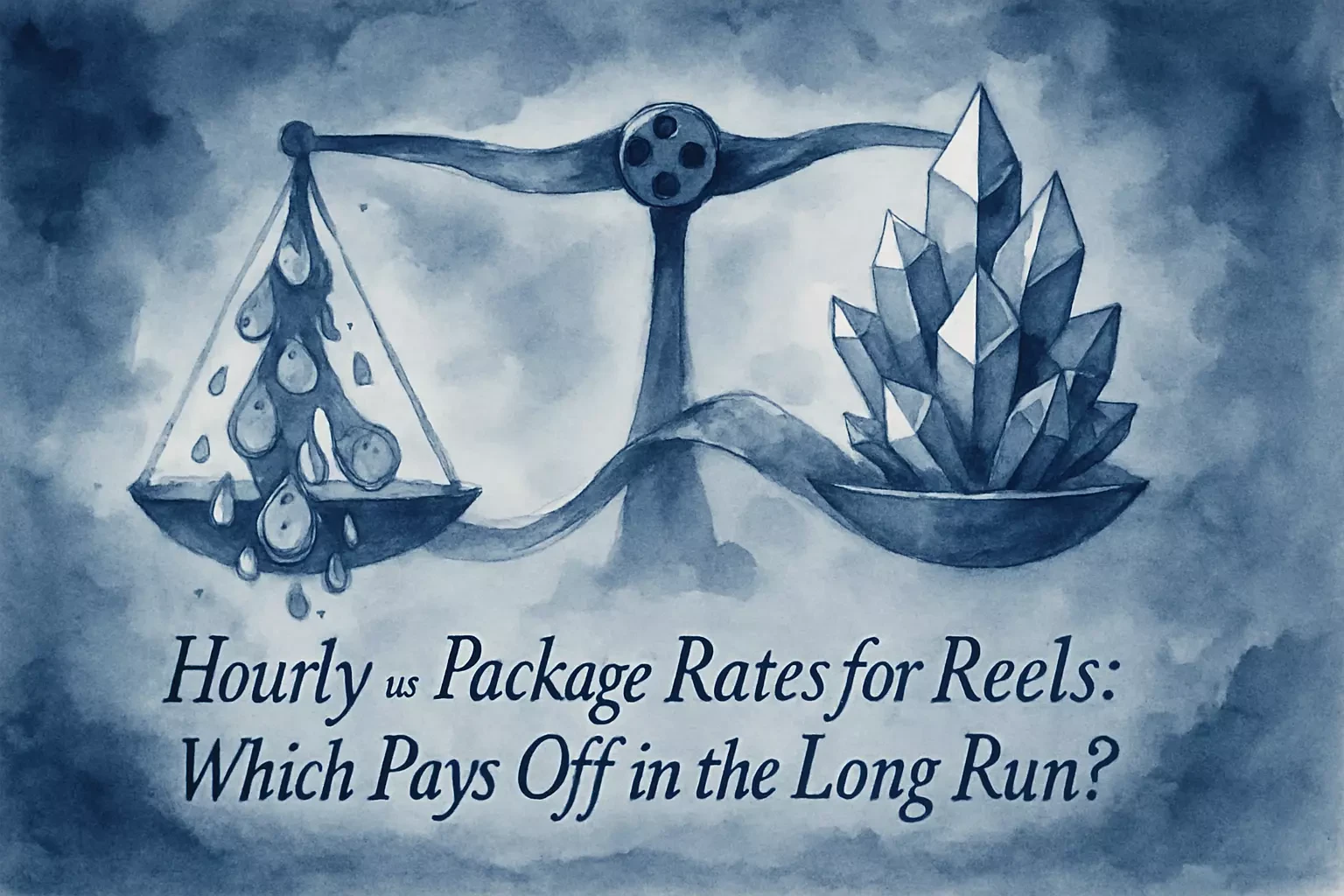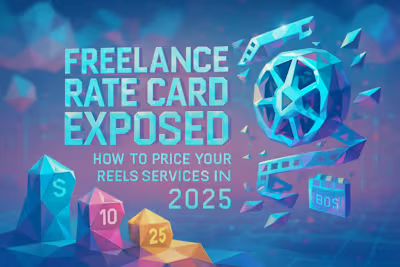Hourly vs. Package Rates for Reels: Which Pays Off in the Long Run?

Hourly vs. Package Rates for Reels: Which Pays Off in the Long Run?
The Case for Hourly Rates
Pros: Flexibility and Guaranteed Compensation
Cons: Client Hesitation and Income Volatility
When Hourly Rates Make Sense
The Power of Package Pricing
Pros: Predictable Income and Higher Perceived Value
Cons: The Risk of Scope Creep
How to Structure Your Reels Packages
Hybrid Models and Making the Final Decision
Combining Packages with Hourly Rates
Which Model Supports Long-Term Growth?
References
Hourly vs. Package Rates for Reels: Which Pays Off in the Long Run?
Choosing between hourly and package-based pricing is a critical decision for any freelance Reels videographer. This choice impacts your income stability, client relationships, and overall business scalability. While a detailed rate card is essential, the pricing structure you choose determines how you earn. In this article, we'll break down both models to help you decide which is best for your long-term success.
We'll also touch on how to close the deal once you've priced it, a skill we explore further in our article on the art of negotiation. Whether you're just starting out or looking to hire freelance Reels videographer services yourself, understanding these pricing models is crucial for success in today's competitive market.
The Case for Hourly Rates
Charging by the hour is a common starting point for many freelancers. It's straightforward and seems to guarantee payment for all time spent, but it has its downsides.
Pros: Flexibility and Guaranteed Compensation
Hourly rates are transparent and flexible, making them suitable for projects with uncertain scopes or those prone to changes. You are compensated for every minute of work, including unexpected revisions or meetings.
Think about it this way: when a client suddenly wants to add three more trending audio options or asks for a complete re-edit because their brand guidelines changed, you're covered. Every Zoom call, every revision round, every "quick change" gets billed. This transparency can actually build trust with certain clients who appreciate seeing exactly where their money goes.
For Reels videographers, this model works particularly well when you're dealing with brands that are still figuring out their social media strategy. Maybe they're testing different content styles or haven't nailed down their brand voice yet. With hourly billing, you can adapt without worrying about eating into your profits.
The flexibility extends beyond just revisions. Let's say you're working with a startup that wants to experiment with different Reel formats. One week they want product demos, the next they're all about behind-the-scenes content. With hourly rates, you can pivot without renegotiating your entire contract.
Cons: Client Hesitation and Income Volatility
Clients can be wary of hourly billing due to fear of costs spiraling out of control. This model also makes income forecasting difficult and can penalize you for being efficient.
Picture this scenario: you've gotten really good at creating Reels. What used to take you three hours now takes one. Great for your skills, bad for your wallet. This efficiency penalty is real, and it's frustrating. You're essentially earning less as you get better at your job.
The unpredictability factor hits hard too. One month you might bill 60 hours, the next only 20. This rollercoaster makes it tough to plan for expenses or save for that new camera equipment you've been eyeing. And forget about taking a vacation without stressing about the income drop.
Client psychology plays a huge role here. When they see an hourly rate, they immediately start doing mental math. "$75 an hour? But what if this takes 20 hours?" That hesitation can kill deals before they even start. Some clients might even start micromanaging your time, questioning why a 30-second Reel took two hours to produce.
When Hourly Rates Make Sense
This model is best for projects with an undefined scope, ongoing consulting work, or when a client's needs are likely to evolve during the project.
New clients who aren't sure what they want yet? Perfect for hourly. That fashion brand that keeps changing direction every week? Hourly protects you from their indecision. Working as a creative consultant where you're brainstorming content strategies? Hourly makes total sense.
Consider these specific scenarios where hourly billing shines:
Experimental projects: When a client wants to "try out" Reels without committing to a full strategy. They might want just a few test videos to see how their audience responds.
Crisis management: A brand needs emergency content for a trending topic or to address a PR situation. The scope is unclear, deadlines are tight, and requirements might change by the hour.
Training and consulting: Teaching a client's in-house team how to create Reels. You're not just creating content; you're transferring knowledge, answering questions, and providing ongoing support.
Long-term retainers: Some clients prefer knowing they have X hours of your time each month to use as needed. This gives them flexibility while providing you with somewhat predictable income.
The Power of Package Pricing
Offering services in packages has become increasingly popular. This model shifts the focus from time spent to the value delivered, which can be more profitable and appealing to clients.
Pros: Predictable Income and Higher Perceived Value
Packages offer clients a clear, upfront cost, which simplifies their budgeting. They also allow you to bundle services, which can increase the total project value and your profit margins.
When you present a package, you're selling a solution, not just your time. "Get 8 professionally edited Reels per month for $2,000" sounds way more appealing than "Pay me $75/hour and hope for the best." Clients love knowing exactly what they're getting and what it'll cost.
The psychology here works in your favor. Instead of clients fixating on how many hours something takes, they focus on the end result. They're buying outcomes, not inputs. This shift in perspective can transform your client relationships from transactional to strategic.
Package pricing also lets you leverage your efficiency. Remember that Reel that now takes you one hour instead of three? With packages, you keep the full value. You're rewarded for getting better and faster at your craft. This incentivizes you to improve your skills and streamline your workflow.
From a business perspective, packages make everything smoother. You can forecast income more accurately, plan your schedule better, and even hire help when needed. When you know you have five clients on monthly packages, you can confidently invest in that new editing software or take that course on advanced transitions.
Cons: The Risk of Scope Creep
The biggest danger with packages is 'scope creep,' where the client asks for more work than was initially agreed upon. This requires a very detailed contract and clear boundaries from the start.
"Can you just add one more Reel this month?" "Could you make the logo bigger in all of them?" "We need landscape versions too for our website." Sound familiar? These innocent-sounding requests can quickly turn your profitable package into a time-sucking nightmare.
Without clear boundaries, clients might assume your package includes unlimited revisions, rush deliveries, or additional formats. Before you know it, you're doing twice the work for the same price. This is where many freelancers get burned and either burn out or start resenting their clients.
The challenge intensifies when dealing with clients who don't understand video production. They might think changing the music on a completed Reel is a "quick fix" when it actually requires re-editing the entire piece to match the new rhythm and mood.
Another hidden danger? Underestimating the time needed. You price a package based on your current speed, but what happens when the client's footage is poorly shot? Or when they want a style that's outside your comfort zone? Suddenly, that profitable package becomes a loss leader.
How to Structure Your Reels Packages
Create tiered packages (e.g., Basic, Standard, Premium) that offer increasing levels of service. A 'Standard' package might include 4 Reels per month, professional editing, and licensed music, while a 'Premium' package could add a content strategy session and faster delivery.
Here's a real-world example of how to structure your packages:
Starter Package ($800/month):
4 Reels per month (15-30 seconds each)
Basic editing with provided footage
One round of revisions per Reel
5-day turnaround
Licensed music from standard library
Growth Package ($1,500/month):
8 Reels per month
Professional editing with color correction
Custom graphics and text overlays
Two rounds of revisions per Reel
3-day turnaround
Trending audio research and recommendations
Monthly performance report
Scale Package ($2,500/month):
12 Reels per month
Advanced editing with motion graphics
Filming assistance (4 hours monthly)
Unlimited revisions
24-hour turnaround available
Content strategy session
Competitor analysis
Cross-platform optimization (Reels, TikTok, YouTube Shorts)
The key is making each tier feel like a significant upgrade. Don't just add more Reels; add more value. Maybe the premium package includes trend research, content planning, or even some filming assistance. Think about what would make a client's life easier and build that into your higher tiers.
Consider adding bonuses that cost you little but provide high perceived value. Access to your content calendar template, a monthly trend report, or priority booking for rush projects can justify higher package prices without significantly increasing your workload.
Hybrid Models and Making the Final Decision
You don't have to choose just one model. A hybrid approach can offer the best of both worlds, providing flexibility while maintaining predictable income.
Combining Packages with Hourly Rates
Offer a set package for a defined scope of work, and specify an hourly rate for any additional requests or revisions that fall outside the package terms. This protects you from scope creep while keeping the core price predictable.
Think of it as a safety net for both you and your client. Your package might include 8 Reels with two revision rounds each. But if they want a third round? That's billed hourly. Need an emergency Reel for a trending topic? Hourly rate kicks in. This approach sets clear expectations while maintaining flexibility.
Here's how this might look in practice:
Your contract states: "Monthly package includes 8 Reels as specified. Additional Reels are available at $150 each. Revision rounds beyond the included two are billed at $75/hour. Rush delivery (under 24 hours) incurs a 50% surcharge."
This hybrid model works especially well for ongoing client relationships. The package provides the stable base income you need, while the hourly add-ons capture the value of extra work. Clients appreciate the predictability of the base package but have options when they need more.
Some videographers take this further by offering different rates for different services. Maybe package work is your bread and butter, but strategy sessions are always billed hourly. Or perhaps you have packages for creation but charge hourly for teaching clients to film their own footage.
Which Model Supports Long-Term Growth?
Analyze which model aligns with your business goals. While hourly is simple, package pricing is often more scalable and positions you as a strategic partner rather than just a hired hand, paving the way for higher-value work.
Let's get real about growth. If you're billing hourly, your income is capped by the hours in your day. Even if you charge $200/hour, there's a ceiling. But with packages, you can serve more clients by becoming more efficient, outsourcing parts of the process, or creating systems that streamline your workflow.
Package pricing also changes how clients see you. You're not just an editor; you're a content partner who understands their business goals. This positioning opens doors to bigger projects, longer contracts, and referrals to other businesses who need strategic video content, not just someone to push buttons in Premiere Pro.
Consider your five-year vision. Do you want to be a solo freelancer trading time for money? Or do you envision building an agency, hiring other editors, and scaling beyond your personal capacity? Package pricing creates the foundation for that growth. You can maintain quality standards while delegating work, something that's much harder with hourly billing.
The data supports this too. Freelancers who transition to package pricing often report 30-50% income increases within the first year. Why? They're capturing the full value of their expertise, not just their time. They're also attracting better clients who value results over hours logged.
Think about your lifestyle goals too. Package pricing can provide the predictable income that lets you plan vacations, invest in equipment, or even take time off for personal projects. When you know exactly what's coming in each month, you can make better business and life decisions.
But here's the thing: there's no universal right answer. Your choice depends on your experience level, client base, and personal goals. New freelancers might start hourly to build confidence and understand their true time investment. Experienced pros might use packages to scale and increase profits.
The sweet spot for many successful Reels videographers? Start with hourly to learn the ropes, transition to hybrid as you gain experience, and eventually move primarily to packages with hourly work for special projects. This evolution mirrors your growth from technician to strategic partner.
Whatever you choose, remember that pricing isn't set in stone. You can adjust your model as you grow, learn, and understand your market better. The key is choosing a structure that serves both your clients' needs and your business goals, then executing it with confidence and professionalism.
Ready to implement your new pricing strategy? Start by analyzing your current clients and projects. Which model would serve them (and you) better? Test your new approach with one or two clients before rolling it out completely. And remember, the best pricing model is the one that helps you build a sustainable, profitable business doing work you love.
References
Like this project
Posted Jun 30, 2025
Hourly or package pricing? Discover which model is best for your Reels videography business to ensure profitability, attract clients, and foster long-term growth.









